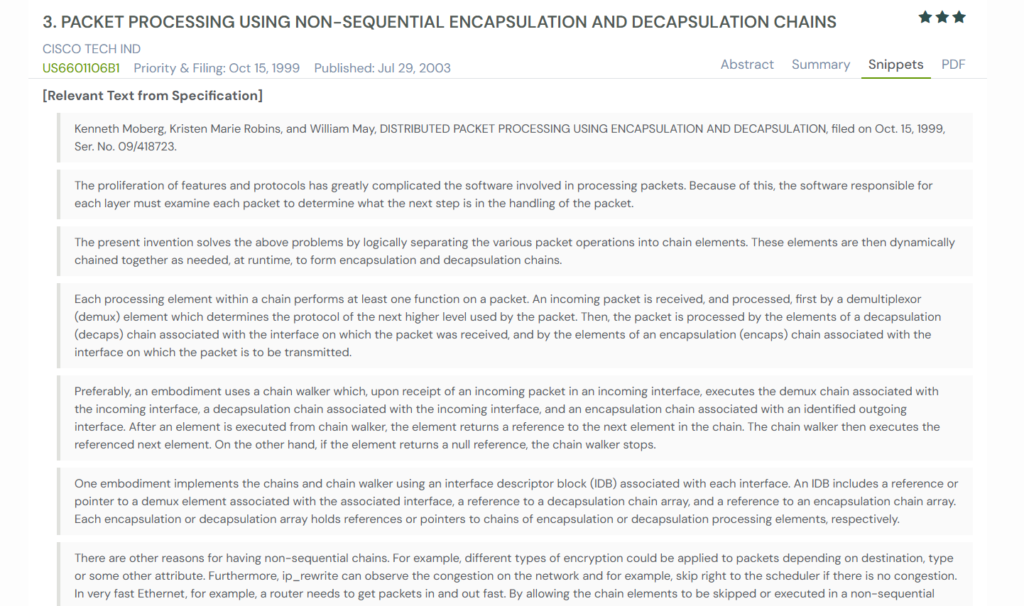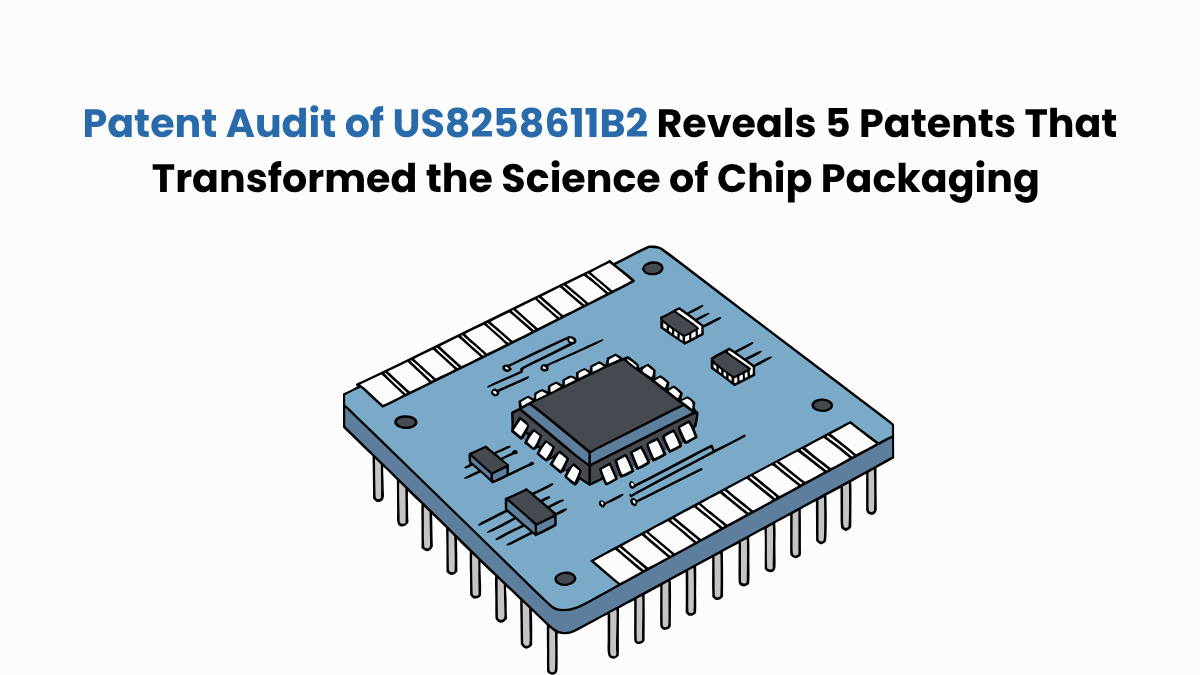Do you know what happens in the background every time you send a file or stream a video? That data does not travel in one straight line. It jumps across layers, routers, and queues before it finally reaches the other end. Each stop adds a bit of delay, a bit of complexity, and a lot of behind-the-scenes chaos that most of us never see.
The patent US9584633B2 tackles that problem head on. Instead of making data hop through multiple network layers, it processes everything in one smooth flow, almost like reading a single tape.
The result is fewer errors, faster routing, and easier address switching even in crowded or unstable networks. The patent which is now central to an active litigation campaign is all about simplifying the journey so data can move smarter, not harder.
To understand how this innovation fits into the larger story of communication systems, we turned to Global Patent Search tool . It helps trace similar patents, uncover design patterns, and show how one breakthrough can influence the next wave of network innovation. But before we look at the findings, let’s get to know a bit more about the subject patent.
How the System Actually Works
The patent, US9584633B2, is focused on making data communication smoother and faster. Normally, when information travels across networks, it hops through several layers, each adding its own steps, checks, and delays. This patent takes a simpler route. It treats data as one continuous stream instead of separate chunks, cutting out unnecessary copying and switching between layers.
It also brings flexibility to how devices manage addresses. Instead of breaking connections every time an address changes, the system assigns multiple addresses to the same entity, allowing quick and seamless switching. Together, these improvements make network communication more efficient, stable, and ready for real-time performance.
Here’s what makes US9584633B2 stand out:
- Streamlined Data Handling: Instead of processing data layer by layer, it treats protocol data units as one continuous flow, reducing delays and boosting efficiency.
- Dynamic Address Management: Devices can hold multiple active addresses, making it easier to switch without dropping connections or losing packets.
- Simplified Multiplexing: The system flattens how data streams are merged and separated, improving overall speed and reducing complexity in routers.
- Enhanced Quality of Service: By grouping data based on delay and latency requirements, it maintains consistent performance even during heavy traffic.
Together, these features make the network more adaptive and resilient, a foundation for faster, more reliable digital communication.
Tracing the Patent Lineage of Modern Network Processing
Every strong invention stands on the shoulders of earlier ideas, and US9584633B2 is no different. To understand its full impact, it helps to look at other patents that tackle similar challenges in network communication, from smarter routing to faster data transfer.
These patents reveal how the industry has been steadily moving toward flatter, more flexible, and efficient network architectures.
Each of the following inventions contributes a unique piece to that puzzle, helping shape how devices communicate, adapt, and recover in real time. Let’s take a look.
1. US7006532B1- Dynamically Building Encapsulation and Decapsulation Chains at Run Time
Routers handle thousands of packets per second, and each one normally passes through a rigid, step-by-step protocol chain. Cisco’s US7006532B1, granted in 2006, changed that. It introduced a flexible system that lets packets pause, skip, or resume at any point in the chain.
Instead of forcing data through a strict step-by-step process, the system allows certain elements like encryption modules or external processors to temporarily take over, then return the packet back into the chain smoothly. This dramatically reduced the overhead that comes with managing multiple network layers.
It connects closely with US9584633B2, which shares the same goal of improving communication efficiency. Both patents aim to simplify how data flows between layers, cutting down on unnecessary processing while maintaining reliability.
Looking Beyond
US7006532B1 laid the groundwork for modern adaptive routing systems. It showed how flexibility inside packet processing could lead to faster and more resilient networks, a direction US9584633B2 continued to refine through smarter protocol handling and dynamic addressing.
2. US6601106B1- Packet Processing Using Non Sequential Encapsulation and Decapsulation Chains
Handling heavy data traffic efficiently requires flexibility, not fixed rules. Cisco’s US6601106B1, granted in 2003, proposed a system where packets could skip redundant processing steps and dynamically adjust their route based on conditions.
It logically separated packet operations into individual chain elements that could be rearranged and executed dynamically at runtime.

This meant routers could make real-time decisions, skipping redundant steps when there’s no congestion or choosing different encryption methods based on packet type or destination. It turned a rigid system into something more adaptive and efficient, cutting down on delays and improving throughput.
The patent ties in well with US9584633B2, which also focuses on optimizing communication flow and reducing processing overhead. While US6601106B1 made packet handling more flexible, US9584633B2 refined how those packets are processed within the network layers, aiming for seamless communication without the extra steps.
Looking Beyond
US6601106B1 helped shape the foundation for intelligent, context-aware routing. By allowing non sequential processing, it paved the way for systems like US9584633B2, which take the same philosophy forward.
Recommended read: If you’re curious how modern networks manage congestion at scale, this analysis of EP3107243B1 breaks down congestion-aware routing ideas. Read to know more.
3. US2002191621A1- Programmable Protocol Processing Engine for Network Packet Devices
Before networks became programmable and software-defined, routers had to rely on fixed hardware chips designed for individual protocols. Every new protocol meant new hardware, new configurations, and a lot of extra cost.
Cypress Semiconductor’s US2002191621A1, published in 2002, changed that by introducing a programmable protocol processing engine. It is a single system that could be reconfigured to handle different network protocols without replacing the hardware.
This engine could process packets across multiple layers of the OSI model by adjusting its parameters in software, eliminating the need for separate chips. This further paved the way for simplified hardware design, reduced manufacturing costs, and gave network operators far more control and flexibility.
The idea aligns closely with US9584633B2, which also emphasizes efficient, flexible network communication. While US2002191621A1 made the underlying hardware adaptable, US9584633B2 streamlined how protocols interact during communication, further cutting down processing time and improving overall network performance.
Looking Beyond
US2002191621A1 was a major step toward today’s programmable and software-defined networking systems. It made it possible for routers and switches to evolve through code rather than components, a vision US9584633B2 built on by enhancing how those systems manage and optimize communication flows in real time.
Did you know? Wireless systems face many of the same packet-hopping challenges described in US9584633B2. Here’s a closer look at how US9031537B2 optimizes data movement across wireless links.
4. US6578084B1 Packet Processing Using Encapsulation and Decapsulation Chains
Cisco’s US6578084B1, published in 2003, tackled one of the biggest pain points in networking i.e. the inefficiency caused by rigid packet processing sequences. Traditionally, every packet moves layer by layer through fixed protocol steps, forcing routers to perform unnecessary operations even when they’re not needed. This patent changed that.
It introduced a method where packets could move through encapsulation and decapsulation chains that were built dynamically at runtime.

These chain elements handled specific functions like demultiplexing, encryption, or routing. A packet could enter, skip, or return to any part of the chain depending on what it required.
For instance, if a packet already had the necessary headers, it could skip the encapsulation stage entirely and jump straight to the output queue. This approach saved time, reduced congestion, and made packet handling far more efficient.
It closely overlaps with US9584633B2, which refined similar ideas for modern, layered communication systems. Both inventions focused on streamlining network communication, Cisco’s through dynamic chain control, and the latter patent through smarter protocol flattening and adaptive processing.
Looking Beyond
US6578084B1 laid the foundation for flexible, modular routing architectures. It helped shape the evolution toward programmable, adaptive networking seen in US9584633B2.
Recommended read: Efficient packet handling is crucial for DoS defense too. This breakdown of US7523497B2 shows how smarter packet-level decisions help prevent overload.
5. US5920705A – Dynamic Shifting Between Routing and Switching Packets
Nokia’s US5920705A, granted in 1999, tackled one of the key challenges in early internet networking i.e. how to handle massive data flows without sacrificing speed or flexibility.
Traditional routers followed fixed IP routing paths, while switches offered faster packet movement but limited intelligence. This patent blended both worlds, introducing a method that allowed a system to dynamically switch between routing and switching depending on the nature of the traffic.
The system used the Ipsilon Flow Management Protocol to group packets into flows based on shared characteristics like source, destination, and policy requirements. Real-time traffic or data requiring guaranteed quality of service could be switched directly using ATM connections for faster handling, while short-lived or query-based traffic continued through standard IP routing.
This hybrid model achieved both performance and reliability, a big step forward for high-speed data networks.
Looking Beyond
US5920705A paved the way for intelligent traffic management, an idea later echoed in US9584633B2, which focused on flattening communication layers to simplify routing. Both patents share a vision of smarter, context-aware data handling, making networks faster and more efficient.
Comparing the Core Networking Innovations
Each of these patents introduced a different way to make network communication faster, more flexible, and less resource-intensive. From Cisco’s modular packet chains to Nokia’s adaptive routing, every idea built upon the same foundation: smarter handling of how data travels across networks.
The table below compares how each invention approaches packet management, efficiency, and scalability, showing how the concept evolved from static processing to dynamic, intelligent communication layers.
| Patent Number | Assignee | Core Innovation | How It Connects to US9584633B2 | Impact on Networking |
| US7006532B1 – Dynamically Building Encapsulation and Decapsulation Chains at Run Time | Cisco Tech Inc. | Created dynamic chain-building for packet processing, allowing real-time flexibility without fixed protocol paths. | Introduced modular packet flow principles that US9584633B2 expanded into fully flattened communication layers. | Reduced protocol dependency and improved router adaptability. |
| US6601106B1 – Packet Processing Using Non-Sequential Encapsulation and Decapsulation Chains | Cisco Tech Inc. | Allowed chain elements to execute in a non-sequential way, skipping unnecessary steps for faster routing. | Shared the same goal of reducing processing overhead by optimizing how packets move through layers. | Paved the way for efficient, congestion-aware routing systems. |
| US6578084B1 – Packet Processing Using Encapsulation and Decapsulation Chains | Cisco Tech Inc. | Used dynamic chain walking to process packets only through relevant tasks, improving system performance. | Reinforced US9584633B2’s concept of streamlined communication layers and flattened architecture. | Enhanced packet handling efficiency in routers and network switches. |
| US5920705A – Method and Apparatus for Dynamically Shifting Between Routing and Switching Packets | Nokia IP Inc. | Enabled systems to switch dynamically between IP routing and ATM switching based on traffic type and QoS needs. | Complemented US9584633B2 by promoting intelligent flow-based decision-making in networks. | Marked an early move toward hybrid routing systems with adaptive control. |
| US2002191621A1 – Programmable Protocol Processing Engine for Network Packet Devices | Cypress Semiconductor Corp. | Proposed a programmable processor to handle multiple network protocols without dedicated hardware. | Influenced US9584633B2’s idea of processing flexibility through software-based architecture. | Reduced reliance on protocol-specific hardware and simplified network scalability. |
Did you know? Wireless communication systems also deal with heavy packet-processing demands. This look at US6813742B2 explores how those optimizations work in the radio layer.
Exploring Innovation Pathways with the GPS Tool
Every patent tells part of a bigger innovation story. The Global Patent Search tool helps you connect those dots uncovering how one breakthrough inspires another across technologies and industries.
Here’s how GPS makes that possible:
- Start with your subject patent: Type a patent number, like US9584633B2, or a short description of the invention, such as a method for managing network communication efficiently. GPS uses this as the foundation to surface related patents that refine or extend similar ideas.
- See what stands out: The tool presents clear summaries from patent claims and descriptions that share overlapping principles. It might reveal other patents that optimize packet flow, flatten communication layers, or enhance routing control.
- Go deeper: You can then check the snippets section to see where the overlap is, and if something looks promising, you can explore the full document to compare how each system handles network processes or minimizes latency.
- Spot cross-domain links: GPS also shows how these communication concepts appear in other areas like IoT systems, edge computing, or adaptive routing for 5G networks. You can further sort by relevance based on what subtechnology areas you want to focus your search on.
The GPS tool helps you trace how ideas evolve, connect, and mature over time.
For US9584633B2, it highlights how today’s adaptive networks stem from early packet-handling frameworks, showing the steady shift toward intelligent, software-driven communication systems.
Try the tool today and see how the dots connect for the invention you have in mind!
Disclaimer: The information provided in this article is for informational purposes only and should not be considered legal advice. The related patent references mentioned are preliminary results from the Global Patent Search tool and do not guarantee legal significance. For a comprehensive related patent analysis, we recommend conducting a detailed search using GPS or consulting a patent attorney.




